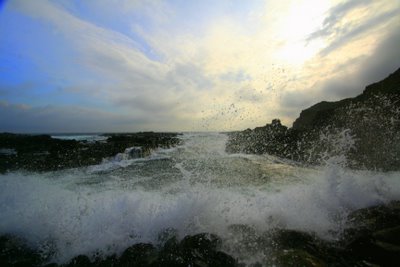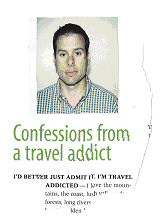The Twelve Apostles
 (Cape Schanck, Australia)
(Cape Schanck, Australia)Each day of our lives, during our waking hours, while we sleep and hundreds of millions of years before that, there is and has been a constant life force at work. Supporting the first evidence of life on the planet, it continues to be a rich source of food and a key environmental player in the global ecosystem. Some creatures live in it, some live on or near it, some harness it for energy, others for fun, and many come to marvel at it. It is the universal connector of all continents and intimately tied to the moon. Through the ages, the oceans of the world have inspired humans to set sail and explore the far reaches of the globe.
While similar in size to the United States, Australia is dissimilar in that the only neighbor with whom it shares a border belongs to the ocean (and seas). And while the ocean waters have been demarcated into different bodies of water by man, the fact remains that they are all connected. With 22,826 miles of beach front property, the southern island continent is home to white sandy beaches and a coastline backdrop of dramatic sandstone cliffs much like coastal Hwy 1 in California.
Throughout my journey, I have been joined by friends, met friends living abroad, and met friends of friends living or traveling abroad. Those experiences have been some of the highlights of my travel, sharing in the joy of finding good pizza when a break from local food was needed, soaking in he daily life in of another culture, or catching the sunrise over a sacred river. All of those experiences were enhanced by the sharing of them. Melbourne would prove to be no different.
Shifting course toward Australia, I e-mailed a friend of mine in the states who had mentioned she had a friend down under. Within hours, I was in contact with Marie, a lifelong Mebournian. She was immediately helpful in giving me some local advice on where and when to go, what to do and how long to stay; infinitely helpful knowledge when tackling a country of vast distances. After exchanging a few e-mails, Marie invited me to Melbourne, offering to show me some of its highlights from a local perspective.
Although it was winter in the south and temperatures ranged from the thirties to the fifties, reflecting on my previous experiences meeting other locals abroad, I flew to Melbourne before heading north for summer like weather and outdoor adventure. With only two full days in town, Marie lined up a packed schedule, driving one day up the eastern coast from Melbourne and up the western coast the next. Marie’s appreciation and enthusiasm for her home state shone through in her ambitious scheduling.
Saturday morning we headed to Cape Schanck for my first hands (and feet) on experience of Australia’s sandy beaches and limestone rock formations dotting the coast. Walking down a plank stairway to the beach, I was surrounded by green golf course like hills on one side and crashing waves on the other. With no specific plan in mind, I walked along the volcanic rocks, spotted with tiny clamshells, the occasional brownish green colored seaweed bundle and pools of water in black molten rock pools. Caught up in the moment, I rounded the cliff, losing sight of the beach where Marie was waiting.
 (Low tide at the Cape.)
(Low tide at the Cape.)Fortunately, it wasn’t long before I realized I was standing in territory belonging to the ocean. The earthen rock beneath my feet spent the better part of its days submerged below the moody ocean waters. A tidal hourglass was ticking, low tide could not hold back the insatiable and unrelenting waters for long so I had to use my time wisely. It was nature’s recess, and when playtime ended, I would either return to land or submit to the sea, well known for having broken many sailing ships like toothpicks. Surely, if they were no match, my chances of survival would be next to nil.

Keeping one eye fixed on the tide, I jumped from rock to rock peering into pools of water and looking for sunken treasure stirred loose by the currents. No one in sight and a vast ocean before me, it was also the perfect time to find out: Do mermaids exist? “Here I am, Daryl Hannah take me away, now’s your chance,” I thought to myself. I was an unwilling victim (well maybe not if it was really Daryl), but curious enough to see if I could get a few snap shots before she slipped back to the depths. Time Magazine, National Geographic, or at worst, The National Enquirer, here I come! But it was not to be. No mermaids, no random gold coins lost in a century old shipwreck, just nature’s gems, starfish, sponges (luffa), coral and lots of beautiful seashells shucked by their former inhabitants lay before me.
Climbing each rock formation not surrounded by the sea, time stood still as it often does when you are a kid lost in your own world (except waiting for birthdays and holidays). Occasional bouts of a conscious awareness hit me as I thought of Marie waiting for me on the other side of the cliffs not knowing where I had gone. I could have kept busy for hours, but with the rising tide, nature moved in to let me know playtime was over. I climbed the hill behind me as my original route was reclaimed by the salty sea and returned to the beach.
Freezing on the beach where I left her, Marie returned to the top of the cliffs where I found her waiting at picnic tables next to the lighthouse. Patient and inquisitive of my exploration, she said nothing of my disappearance for hours for which we had not planned. Coastal exploration behind us, we headed to Flinders, one of many small but well to-do towns, where many Meblournians have weekend homes on horse ranches. Stopping for the local custom “tea time”, we stumbled on to an art show exhibiting talented area artists before returning to the city.
The following day involved a day long road trip through more rolling green hills and quaint seaside towns to the “Twelve Apostles”. One of the most photographed geologic features in Australia, the apostles are the last rocks standing just off the coastline, surrounded by the crashing ocean waves. After a few unplanned, if not accidental detours, we arrived at the rugged coastline just before sunset. Clouds overhead played hide the ball of fire, teasing my “trigger” finger poised on the camera waiting for the sun’s re-emergence. As the last rays of sunlight danced on the white caps chipping away at the base of the apostles, a full moon rose on the purple horizon.
 ("Twelve Apostles" standing in a moody ocean at sunset.)
("Twelve Apostles" standing in a moody ocean at sunset.)Back in Melbourne, even after a twelve hour tour, we drove through the streets of the Central Business District or “CBD” and the surrounding neighborhoods. Even from street level it is easy to see why Melbourne was ranked the most livable city a decade ago. With green parks, clean streets, low crime, grand architecture, international cuisine and cafes to keep your java pangs satiated for several lifetimes, one of the country’s main economic hubs still manages a small town feel. Top that off with access to hot summer beaches, a thriving art culture and lots of open space just a few kilometers from the city center and you have a model city.
Early the next morning, Marie gave me a lift to the airport for the next leg of my trip. Thanking her for her open home hospitality and enthusiasm for sharing her hometown with me, I smiled as I was again reminded about the generosity of people, once strangers to me, now friends made along the way. Melbourne would no be exception as I now had a new friend down under.


<< Home